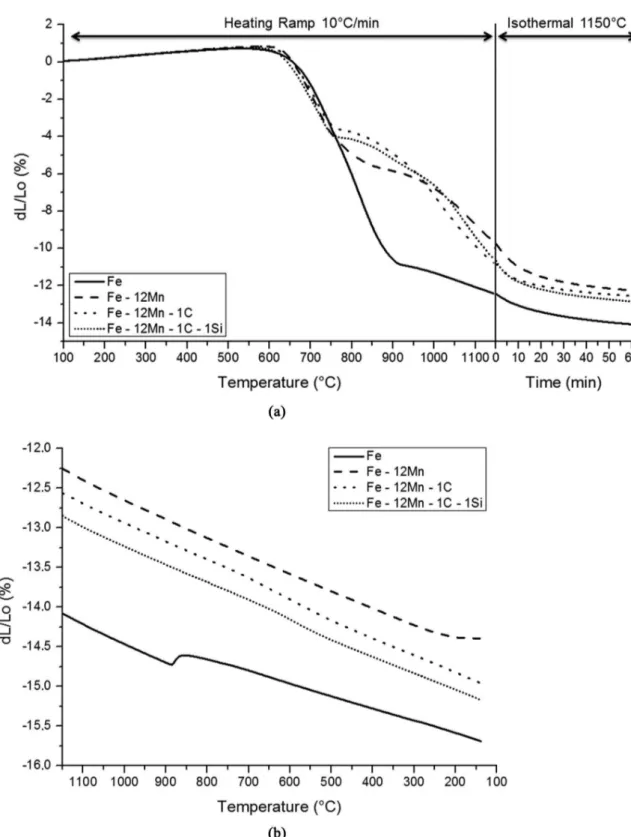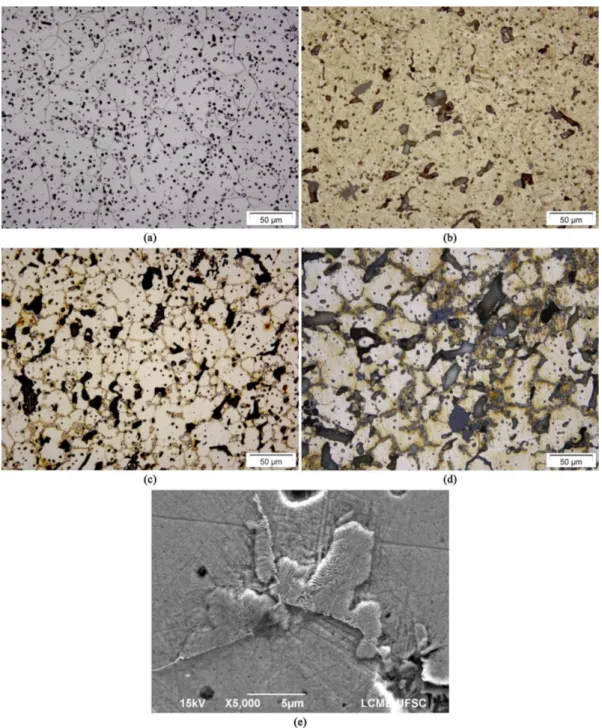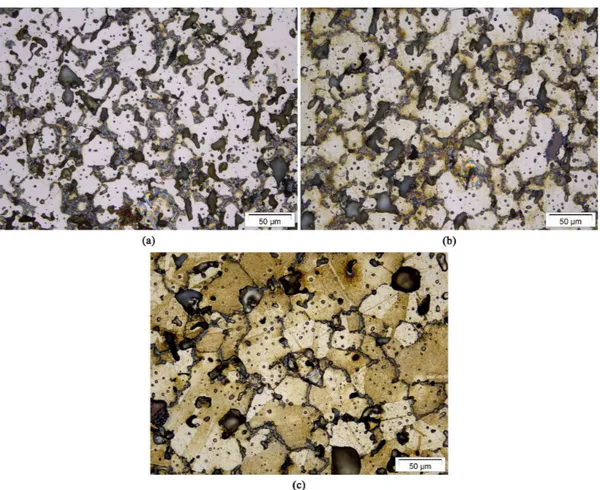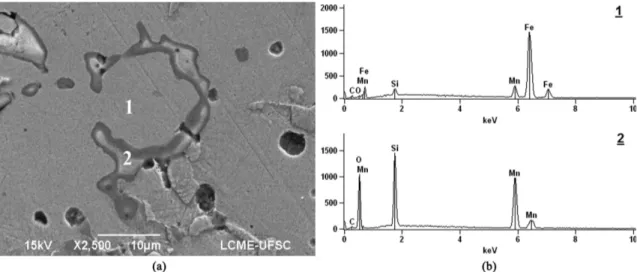*e-mail: renan.m.schroeder@embraco.com
1. Introduction
High manganese austenitic steels, commonly known just by Hadield steels, were introduced by Sir Robert Hadield1. They are known for a good combination of strength, toughness and impact wear resistance. Despite their use in several industry sectors for a long time, the exact origin of these properties is still complex and dependent of several factors such as chemical composition, working temperature and applied stress. Nevertheless, the main explanations for the high work-hardening behavior revolve around dislocations glide, dynamic strain ageing (serrated yielding), ε or α’ martensite transformation and twinning2.
An optimal performance of Hadield steels is therefore dependent of occurrence of these metallurgical effects during the engineering application and, because of that, the rigid control of microstructure is of fundamental importance, thus opening good opportunities to powder metallurgy techniques. Cazzolli et al.3 also already suggested the production of Hadield steel by powder metallurgy as an interesting alternative to eliminate machining operations frequently necessary in cast products.
Despite that, the production of sintered steels containing manganese has been a challenge along the last decades4. Looking at Ellingham`s diagram for oxides, it is clear that Mn present higher thermodynamic stability compared to other more traditional elements of powder metallurgy, e.g. Ni or Cu. This means that if Mn oxidizes during the sintering, its reduction becomes hardly possible at conventional sintering temperatures and, as a consequence, undesired oxides will be part of the inal microstructure.
Ellingham`s diagram also shows that manganese oxide can be reduced only by reaction with carbon atoms, forming carbon monoxide and carbon dioxide, consequently reducing the total amount of carbon in the Hadield alloy. Carbon deviation can lead to localized formation of martensite instead of the fully austenitic microstructure, therefore, also affecting the steel performance.
High sintering temperature may also be a problem for Mn alloys due to the high vapor pressure of Mn, which results in sublimation of Mn atoms during the sintering5. The consequences are chemical deviations mainly at the parts surfaces and contamination of furnace components, like heaters, thermocouples and setter plates. Strategies to overcome this effect are based on the reduction of Mn activity in the alloy, mainly with the use of ferromanganese, master alloys or prealloyed powders rather than pure elemental Mn powder4-6. The high vapor pressure of Mn also prohibits the use of vacuum furnaces which are widely used in the metal injection molding industry. The same sublimation issue can occur also for other elements, e.g. copper, as showed by Schroeder et al.7 during an investigation of plasma sintering for 17-4 PH stainless steel.
Another fact that has an important role in the microstructure formation of Hadield alloys is the liquid phase present in the Fe-Mn-Si system. The presence of eutectic phases is dependent of localized chemical composition and sintering temperature, therefore, also related to the sintering cycle. Liquid phase in Fe-Mn-Si ternary system was irst studied by Salak8 during sintering of Mn alloys.
Because of such phenomena, it is necessary to tailor correctly the sintering cycle of Hadield steels in order
Adjusting the Sintering Cycle of a Hadield Sintered
Steel Produced by Metal Injection Molding
Renan Schroedera,b*, Antonio Itamar Ramos Filhoa, Cristiano Bindera, Aloisio Nelmo Kleina
aMaterials Laboratory, Universidade Federal de Santa Catarina – UFSC, Rua Delino Conti, s/n, Trindade, CEP 88040-370, Florianópolis, SC, Brazil
bEmbraco, Rua Rui Barbosa, 1020, Distrito Industrial, CEP 89219-521, Joinville, SC, Brazil
Received: November 9, 2014; Revised: September 6, 2015
Processing of high manganese austenitic sintered steels present several challenges concerning thermodynamic reactions that occur during the sintering of these materials such as Mn oxidation, sublimation and even the formation of liquid phases or undesired compounds, e.g. grain boundary carbides. Therefore it is extremely important to adjust the sintering parameters to obtain the adequate microstructure and properties. In this work, the effect of some sintering parameters, i.e. temperature, gas atmosphere and cooling rate are studied by dilatometry. The experiments revealed that the sintering temperature has small impact on the microstructure formation. On the other hand, the decrease on oxygen chemical potential in the furnace atmosphere resulted in less oxidation of the powder particles. Moreover, the increasing on the cooling rate to 50 °C/min avoided the formation of grain boundary carbides. As a main conclusion, a special sintering cycle for Hadield steel samples was suggested.
to have the adequate inal fully austenitic microstructure. In this work, the inluence of temperature, gas atmosphere and cooling rate were studied before setting up the inal sintering cycle.
2. Experimental Procedure
The alloy mixtures were prepared with commercially available powders of carbonyl iron (Sintez, grade BM), graphite (Nacional do graite, d50: 11 µm), ferrosilicon (Sandvik, Fe45Si-d90:22 µm) and ferromanganese (Chemalloy, LC 60 × 325 mesh) powders. They were mixed in an appropriate amount to obtain the materials presented in Table 1. The three materials without Si in their composition were used only to investigate the inluence of each powder on the sinterability of the Hadield steel. The powder loading was set at 92%wt, with a binder system based on polypropylene and parafin wax.
Cylindrical specimens suitable for the dilatometric runs were injection molded in industrial conditions and debound in a two-fold route. The irst extraction occurred in hexane at 50 °C during 6 hours, while the second was carried out in a plasma furnace, developed in-house and described in other works9,10. Debinding temperature did not pass 600 °C in order to avoid excessive pre sintering already at low temperature. Sintering was further studied in the dilatometer (Netzsch DIL 402C) and, in particular, the effects of alloying powders, sintering temperature, gas atmosphere and cooling rate, as summarized in Table 2. Heating rate (5 °C/min) and dwell time (1 hour) were kept constant in all experiments.
The irst study consisted therefore of sintering the four materials described in Table 1 at 1150 °C, with the goal of understanding the effect of each alloying powder on the sinterability of the Hadield steel.
In order to analyze the effect of the sintering temperature, Hadield steel samples were sintered also at 1200 °C and 1250 °C and compared with results at 1150 °C.
The effect of gas atmosphere was addressed by changing the atmosphere composition from a mixture of 95% Argon + 5% Hydrogen to 100% Argon. These two batches were compared with a third atmosphere also composed by 95% Argon + 5% Hydrogen, however with lower oxygen chemical potential. This was achieved by passing the gas mixture into a chamber containing oxygen scavengers (Ti chips) before lowing it into the sintering chamber.
The last experiment consisted of cooling the sample after isothermal sintering at 50 °C/min, which was the maximum rate achievable in the dilatometer.
After all these experiments, samples were characterized in order to understand the relations between sintering process and inal microstructure and to be able to set an adequate sintering plan for Hadield steel samples produced by metal injection molding.
3. Results and Discussions
3.1. Inluence of alloying powders
Figure 1a presents the dimensional changes of the four mixtures, presented in Table 1, during heating up and isothermal holding inside the dilatomer. The horizontal axis of this graphic shows initially the temperature, associated to the heating stage and, later on, the time related to the isothermal holding.
All powder compacts expand in a very similar way up to 600 °C, at which shrinkage becomes predominant over the thermal expansion. In other words, the increase in shrinkage rate is representing the effective start of sintering, which seems to be not inluenced considerably by the composition of the powder compacts.
Alpha/gamma transformation, which for plain iron is found at ≈ 910 °C, occurs early for the materials containing the other alloying powders. For Fe-12Mn it is slightly shifted to ≈ 850 °C, while for Fe-12Mn-1C and Fe-12Mn-1C-1Si it occurs at ≈ 750 °C. The shifts in transformation temperatures are due to the diffusion of Mn and C atoms in the iron lattices already at low temperature during the heating up. Silicon, which is an alpha stabilizer, seems to not inluence in a great manner the α→γ transition.
Table 1. Chemical composition of the mixtures produced in the study.
Material Fe (%wt) Mn (%wt) C (%wt) Si (%wt)
Fe 100.0 - -
-Fe-12Mn Bal. 12.0 -
-Fe-12Mn-1C Bal. 12.0 1.0
-Fe-12Mn-1C-1Si
(Hadield) Bal. 12.0 1.0 1.0
Table 2. List of tests carried out to understand the effect of alloying powders, sintering temperature, gas atmosphere and cooling rate.
Tests Material Temperature Gas atmosphere Cooling rate
Alloying powders
Fe
1150 °C 95%Ar + 5%H2
(Ti chips) 10 °C/min
Fe-12Mn Fe-12Mn-1C Fe-12Mn-1C-1Si
Temperature Fe-12Mn-1C 1200 °C 95%Ar + 5%H2
(Ti chips) 10 °C/min
1250 °C
Gas atmosphere Fe-12Mn-1C 1200 °C 100%Ar 10 °C/min
95%Ar + 5%H2
Cooling rate Fe-12Mn-1C 1200 °C 95%Ar + 5%H2
Finally, during the isothermal holding, only the reduction of the sintering rate is seen, which is explained by the increase in densities.
Figure 1b shows the dimensional changes occurring during the cooling. As expected, plain iron shows the α→γ
transition at ≈ 900 °C; Fe-12Mn shows an inlection only at ≈ 200 °C which in this case is associated to the transformation of the retained austenite into martensite. According to De Cooman et al.11, the complete stabilization of austenite at room temperature for the Fe-Mn system occurs only
Figure 1. Dimensional changes during sintering of the materials presented in Table 1. (a) Heating and isothermal holding. (b) Cooling.
towards at least 27%wt. of Mn. On the other hand, both Fe-12Mn-1C and Fe-Fe-12Mn-1C-1Si do not present any visible phase transition during cooling, which is a good suggestion that austenite has been stabilized at room temperature.
In order to conirm those assumptions, the sintered samples were characterized in terms of standard metallography (Figure 2a-f). Plain iron presents only the expected ferrite (Figure 2a) with rounded and small pores; addition of 12%wt. of Mn changes the microstructure to martensite (Figure 2b) and also introduces larger secondary pores in the microstructure, which come from the dissolution of
ferromanganese in the alloy. Furthermore, the presence of Mn-rich oxides, which were not dissolved in the matrix and now might be considered defects, are also seen in this microstructure.
In Fe-12Mn-1C (Figure 2c) and Fe-12Mn-1C-1Si (Figure 2d), it is found austenite in the core of the grains and precipitates along the grain boundaries (Figure 2e), which, probably, are carbides formed during slow cooling inside the dilatometer. Another interesting fact was that when adding C, the Mn-rich oxides were not visible in the
Figure 2. Microsctructural chracterization (specimen core areas) of the four materials presented in Table 1. (a) Fe. (b) Fe-12Mn.
inal microstructures, probably meaning that they have been minimized by carbothermal reductions.
3.2. Inluence of sintering temperature
The irst study showed mainly three problems related to the development of Hadield steels by metal injection molding: precipitates in the grain boundary, large secondary pores and in some cases oxidation. The irst problem is already elucidated in the literature12 and it is quite obvious that Hadield samples must undergo a heat treatment such as solution annealing followed by quenching to obtain the fully austenitic microstructure. Despite knowing this necessity, this preliminary work was focused only at the MIM aspects, so heat treatments were not addressed in the current investigation.
On the other hand, the other two issues have large relation with sintering and in fact there are several possible alternatives to repair them. The irst parameter to choose was the sintering temperature as it is known that when increasing it, densiication (minimization of the porosity) normally can be improved and also oxidation minimized due to the lower thermodynamical stability of oxides at higher temperature. Figure 3 shows the dimensional changes of the Hadield samples sintered at three different temperatures during the whole sintering cycle. The curves are almost identical with only small differences in the shrinkage of the alloy sintered
at 1250 °C. The formation of liquid phase during sintering was surprisingly not evident in these analyses.
The microstructures, showed in Figure 4a-c, did not reveal also any signiicant difference among the alloys. They remained austenitic with grain boundary precipitates, and the large secondary pores were not eliminated or even minimized, but only became more rounded. Furthermore,
Figure 3. Dimensional changes of Hadield samples sintered at
1150 °C, 1200 °C and 1250 °C. Author: Renan Schroeder.
Figure 4. Microstructural characterization (core areas) of Hadield steel sintered samples processed at 1150 °C (a), 1200 °C (b) and
there is, to some extent, coarsening of the grains in the samples sintered at 1250 °C.
It is possible to say that at least, based on these results, the sintering temperature does not have a large inluence on the sinterability and microstructure formation of the Hadield steel. Despite that, it is recommended to use low sintering temperature due to the Mn sublimation. The high porosity seems to be related to the particle size of the ferromanganese powder, which was to some extent higher than the ideal to metal injection molding.
3.3. Inluence of gas atmosphere
Figure 5 presents the dimensional changes of the Hadield alloys sintered in different gas atmosphere conditions. The differences start to be more intense after ≈ 1000 °C, in particular for the sample sintered under 95%Ar + 5%H2 (Ti chips). The cleaner atmosphere seems to allow this alloy to sinter faster, probably due to the absence of oxides in the powder surfaces.
When analyzed the microstructures of samples sintered in conditions without Ti chips, it is clear the presence of oxides surrounding FeSi particles, such as those in Figure 6a. EDS analysis,
Figure 5. Hadield steel samples sintered under different conditions of gas atmosphere. Author: Renan Schroeder.
Figure 6. SEM analysis showing oxidation in atmospheres containing higher amounts of oxygen. (a) SE image. (b) EDS analyses of
present in Figure 6b, conirmed that those structures have high oxygen level, therefore characterizing oxides.
Silicon has high diffusion rate in Fe-Mn system, so when it is free, i.e not oxidized, it shall induce higher shrinkage rates, exactly as observed in the diltometric results on Figure 5.
3.4. Inluence of cooling rate
Carbides have a large tendency of precipitation in Hadield steel microstructure during its cooling from any thermal process if not controlled properly the cooling rate, as showed in Figure 2e. Basically there are two types of carbides: thin or thick. Thinner carbides, smoothly formed in the grain boundaries, are less aggressive to the mechanical properties and, therefore, less important in the microstructure. On the other hand, thick carbides, originally formed from coarsening of thin carbides, are detrimental to the mechanical properties of the steel and must be avoided. Thick carbides
Figure 7. Microstructure of Hadield steel sample obtained in a
cycle with high cooling rate (50 °C/min). Author: Renan Schroeder.
can be normally characterized by the presence of cementite lamellas and mixed carbides inside of an austenitic area.
Looking at the elimination or at least reduction of thick carbides, the last experiment consisted of cooling the sintering chamber at 50 °C/min, which was the maximum cooling rate achievable in the dilatomer. The results of the microstructure analysis, presented in Figure 7, clearly conirmed a massive reduction of carbides, which even complicated the identiication of grain boundaries, due to the lower effect of etchants in these areas.
4. Conclusions
Processing of Hadield steels by metal injection molding is feasible. In terms of processing conditions it is recommended:
a) S i n t e r i n g t e m p e r a t u r e : 1 2 0 0 ° C . H i g h e r temperatures can lead to Mn sublimation, which may change superficial properties and lead to furnace deterioration, while lower temperatures may impact densiication and alloy homogenization.
b) Gas atmosphere: Argon + 5%Hydrogen + oxygen scavengers, e.g. Ti chips, to reduce oxygen chemical potential. As cleaner is the atmosphere, cleaner will be the microstructure in terms of oxides.
c) Cooling rate: at least 50 °C/min, in order to reduce precipitation of grain boundary carbides.
Acknowledgements
The authors thank the Brazilian agencies Capes, CNPq, FAPESC, BNDES and the company Embraco for the inancial support. Additionally, we thank the Laboratory of Microscopy (LCME) from our university for the SEM analysis.
References
1. Hadfield RA. Hadfield’s manganese steel. Science. 1888; 12(306):284-286. PMid:17840151.
2. Bouaziz O, Allain S, Scott CP, Cugy P and Barbier D. High manganese austenitic twinning induced plasticity steels: A review of the microstructure properties relationships. Current Opinion in Solid State and Materials Science. 2011; 15(4):141-168. http://dx.doi.org/10.1016/j.cossms.2011.04.002.
3. Cazzolli M, Menapace C, Perina M and Molinari A. Microstructure and tensile properties of Hadfield steel produced by Metal Injection Moulding. In: Proceedings of the Euro PM Congress & Exhibition; 2012; Basel. Shrewsbury: EPMA; 2012. 7 p.
4. Hryha E, Dudrova and Nyborg E. Critical aspects of alloying of sintered steels with manganese. Metallurgical and Materials Transactions. A, Physical Metallurgy and Materials Science. 2010; 41(11):2880-2897. http://dx.doi.org/10.1007/s11661-010-0357-5.
5. Salak A. Sintered manganese steels, part 2: manganese evaporation during Sintering. Powder Metallurgy International. 1980; 12:72-75.
6. Zhang Z and Sandström R. Fe-Mn-Si master alloy steel by
powder metallurgy processing. Journal of Alloys and Compounds. 2004; 363(1-2):194-202. http://dx.doi.org/10.1016/S0925-8388(03)00462-6.
7. Schroeder R, Hammes G, Binder C and Klein AN. Plasma
debinding and sintering of metal injection Moulded 17-4PH stainless steel. Materials Research. 2011; 14(4):564-568. http:// dx.doi.org/10.1590/S1516-14392011005000082.
8. Salak A. Manganese sublimation and carbon ferromanganese liquid phase formation during sintering of premixed manganese steels. The International Journal of Powder Metallurgy & Powder Technology. 1980; 16(4):369-379.
9. Wendhausen PAP, Fusão D, Klein AN, Muzart JLR, Ristow W Jr and Machado R. Plasma assisted debinding and sintering:
process and equipment. In: Proceedings of the PM World Congress & Exhibition; 2004; Vienna. Shrewsbury: EPMA; 2004. p. 137-142.
10. Klein A, Cardoso RP, Pavanati HC, Binder C, Maliska AM,
11. De Cooman BC, Chin KG and Kim J. High Mn TWIP steels for
automotive applications. In: Chiaberge M, editor. New trends and developments in automotive system engineering. Rijeka:
Intech; 2011. p. 101-128.
12. Kuyucak S, Zavadil R and Gertsman V. Heat-treatment processing




